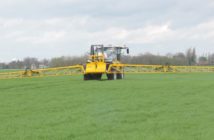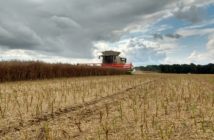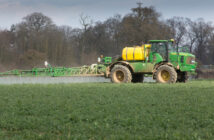With over twenty days of rain already recorded at Boxworth since August 1st growers are being warned of an earlier than usual Phoma risk.
With the showery conditions of August continuing into September, ADAS plant pathologist Dr Faye Ritchie urges growers to be vigilant. “Many areas have had a similar weather pattern to what we’ve seen at Boxworth so we may see the disease earlier this season. Growers should be on the lookout as early as the first week of October.”
A serious concern for Dr Ritchie this season is late sown crops following harvest delays, which she says are particularly vulnerable. “Smaller plants are at greater risk from Phoma as the distance the fungus has to travel from the leaf to petiole to stem is shorter,” she cautions.
She advises growers to monitor crops regularly and ensure timeliness of applications. “Good control of Phoma can be achieved if fungicides are applied at the appropriate timings. Treating Phoma leaf spotting successfully will decrease the development of stem canker which will reduce yield loss. The best chance to protect plants is to treat initially when the 10 – 20% plants affected threshold is reached.”
And timing is key she stresses. “The second application should be applied when re-infection occurs and this will be dependent on weather. Providing applications are well-timed, even small crops should be adequately protected,” she notes.
Tim Nicholson, Commercial Technical Manager for Bayer CropScience, is also alarmed by the early onset of the disease this season but is more concerned with follow up foliar applications. “If the weather remains unsettled it could mean growers will need to get back in to protect against the spread of Phoma, the interval between initial treatment and follow up could be as short as four weeks with more susceptible varieties.
“With an earlier than usual Phoma application likely this year it is still important to follow up with a further application later in the autumn to top up earlier Phoma sprays and also to protect against the greater threat of light leaf spot (LLS). Leaving a gap of up to five months from October to a stem extension spray could leave the door open to significant infection from LLS. Any follow up application will need to be effective against both diseases.
“For Phoma and LLS there’s still no better choice than prothioconazole. Used at the first timing it will provide good Phoma control and help with any early LLS infections. Even with the arrival of new chemistry the most effective autumn Phoma and LLS strategy is a 0.32 L/ha dose of Proline275 (prothioconazole) followed by 0.32 – 0.46 L/ha in November or December,” he suggests.



